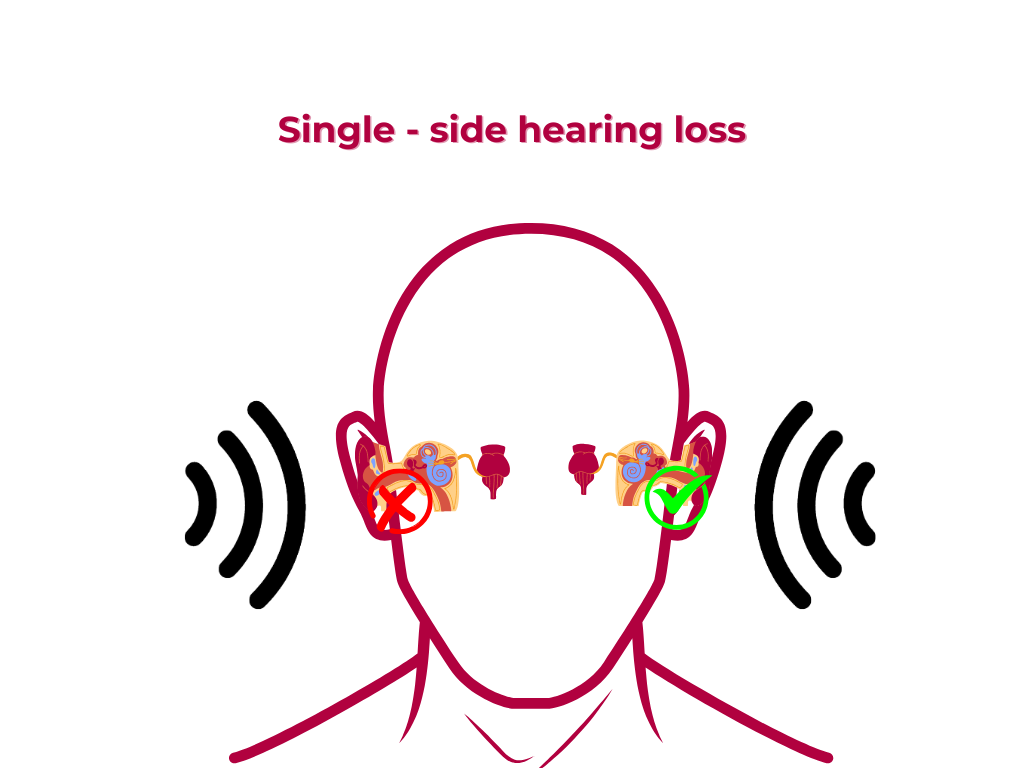Unilateral conductive hearing loss (UCHL) occurs when there is a problem with the middle ear that affects sound conduction to the inner ear, resulting in hearing loss in one ear.
Below are the Diagnostic Evaluation And Management Options.
Diagnostic Evaluation
Step 1: History and Physical Examination
-
Medical history
Ask about ear infections, trauma, or previous ear surgery, any history of Epistaxis, nasal obstruction, rhinorrhea, anosmia, hyposmia, tinnitus, headache, blurring of vision or double vision, numbness on the face or teeth. Also ask about presence of cough, abdominal pains, pains in the limbs etc.
-
Physical examination
Examine the ear canal and tympanic membrane using an otoscope. Do anterior and posterior rhinoscopy looking for nasal mass, postnasal mass, examine all cranial nerves. Examine neck looking for enlarged lymph nodes. Examine all other systems especially chest, long bones
Step 2: Audiological Evaluation
-
Pure tone audiometry
Assess hearing thresholds in both ears.
-
Tympanometry
To assess middle ear pressure and acoustic reflexes.
-
Speech audiometry
Evaluate speech recognition and understanding.
-
Otoacoustic emissions (OAEs)
Measure the sounds produced by the inner ear.
Step 3: Imaging Studies
-
Computed Tomography (CT) scan
Evaluate the middle ear and temporal bone.
-
Magnetic Resonance Imaging (MRI)
Assess the inner ear and auditory nerve.
Step 4: Specialized Tests
-
Electronystagmography (ENG)
Evaluate vestibular function.
-
Electrocochleography (ECog)
Measure the electrical activity of the inner ear.
Management
Step 1: Medical Management
-
Antibiotics
Treat middle ear infections.
-
Nasal decongestants
Relieve nasal congestion.
-
Ear drops
Treat earwax buildup or outer ear infections.
Step 2: Surgical Management
-
Myringotomy and tympanostomy tube insertion
Relieve middle ear fluid buildup.
-
Tympanoplasty
Repair the tympanic membrane and middle ear bones.
-
Ossiculoplasty
Repair or replace the middle ear bones.
-
Mastoidectomy
Remove infected mastoid bone tissue.
-
Endoscopic biopsy
Endoscopic biopsy of the postnasal space if tympanogram shows type B or C, to rule out nasopharyngeal carcinoma.
Step 3: Amplification and Rehabilitation
-
Hearing aids
Recommend hearing aids to improve communication.
-
Bone-anchored hearing aids (BAHAs)
Consider BAHAs for single-sided deafness.
-
Cochlear implants
Consider cochlear implants for severe to profound hearing loss.
-
Aural rehabilitation
Provide auditory training and speech reading instruction.
-
chemotherapy / radiotherapy
If biopsy positive for nasopharyngeal carcinoma to refer for chemotherapy / radiotherapy
Step 4: Follow-up and Monitoring
-
Regular follow-up appointments
Monitor hearing and adjust treatment as needed.
-
Hearing aid adjustments
Adjust hearing aids to ensure optimal performance.
-
Surgical follow-up
Monitor for post-surgical complications, complications of chemo radiotherapy and adjust treatment as needed.
Share Post On:
Recent Posts
-
Nuggets of ORL-RHINOLOGY
-
Nuggets of Otorhinolaryngology-Basic sciences
-
Anatomy of the Muscles of the Soft Palate
-
Ethmoidal Arteries Ligation for Epistaxis
-
Submucous Cleft Palate (SMCP)
-
Approach to Ligation of the External Carotid Artery
-
Approach to Managing a 3-Year-Old Boy with a Foreign Body in the nasal cavity.
-
Approach to Managing a 3-Year-Old Boy with a Foreign Body impacted in the ear canal.
-
Endoscopic Sphenopalatine Artery Ligation (ESPAL) for Epistaxis
-
Surgical Management of Epistaxis
-
Technique of Incision and Drainage of Septal Hematoma/Septal Abscess
-
Upper Aerodigestive Tract Foreign Body Impaction
-
Incision and Drainage of Hematoma Auris
-
Rigid Bronchoscopy for Retrieval of Foreign Bodies in Children
-
Foreign Body Impaction in the Larynx, Trachea, and Bronchi
-
Leadership Position is a Tool, not a Trophy
-
Carcinoma of the Oropharynx
-
Peritonsillar Abscess
-
Ethics of Doctor-Patient Relationship
-
Doctor-Patient Relationship Case Scenarios
Categories
Get in Touch
Read doctor-produced health and medical information written for you to make informed decisions about your health concerns.


